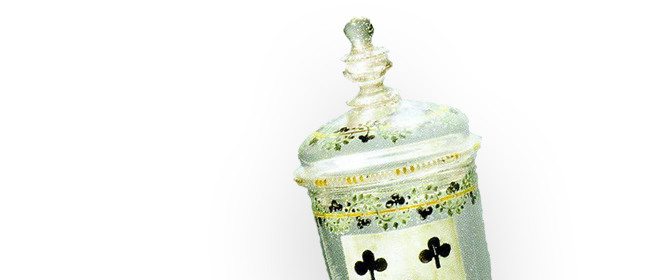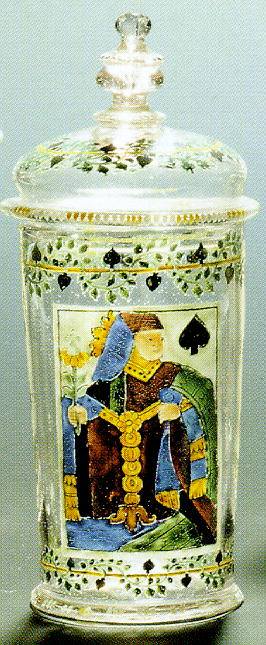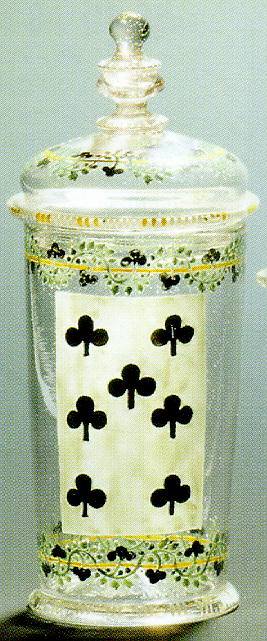
Glass Game of Chance
Doris Kachel | 14 April 2020
The Day of Provenance Research, initiated by the “Arbeitskreis für Provenienzforschung“ (Working group for provenance research), takes place once every year in April. On this day the museums present their current research strategies and principal lines of inquiry. In the DHM blog our provenance researchers shed light on their usually meticulous detective work in searching for the origin and original owners of the objects. In the second article on this topic Doris Kachel describes her current investigations on lidded glass beakers from the Ministry of Finance of the GDR that were in the collection of the Museum für Deutsche Geschichte in East Berlin and were then transferred to the collection of the Deutsches Historisches Museum.
On 30 September 1955 the Museum für Deutsche Geschichte (MfDG), the central museum of history of the GDR, took an impressive set of seven lidded glass beakers with playing card motifs into its collections. The beakers were produced in the first third of the 18th century and are decorated with colourful enamel paintings that show the jack of spades, the queen of clubs, the nine of diamonds, the six of hearts and other cards. Some of them can be seen in our Permanent Exhibition. It is likely that they were part of a set of 52 glasses. It has not been established whether they belonged to a drinking game or were simply used for refreshment during a game of cards.

Lidded beaker with enamel painting: queen of spades, 18th century © DHM
The glasses, together with numerous other glass vessels, were acquired by the museum from the Ministry of Finance of the GDR in East Berlin. Since one of the main areas of a two-year research project[1] of the Deutsches Historisches Museum in cooperation with the German Center for Lost Cultural Assets is research into transfers of objects from the Ministry of Finance of the GDR to the MfDG,[2] the matter of the glasses raises a number of questions: Where did the Ministry of Finance get the numerous glass drinking vessels from? Did they perhaps come from so-called “castle recoveries” or from goods that were left behind by people who had fled from the GDR? Are the glasses part of a whole set?

Lidded beaker with enamel painting: seven of clubs, 18th century © DHM
In the research project on the transfer of goods from East German state institutions and organisations to the MfDG, I am examining in particular acquisitions from the “Tresorverwaltung”, an independent department of the Finance Ministry that was a kind of depot administration and acted as the responsible central office for the disposal of all valuables and precious objects confiscated and impounded after 1949, such as gems, precious metals and porcelain.
The valuable glasses in our collection fit into this category. Through the examination of the MfDG inventory book and our museum’s own database it was possible to identify more than 50 individual objects that were acquired by the GDR Finance Ministry in the year 1955. A more thorough provenance research therefore seemed urgently needed.
It began with an investigation of the Tresorverwaltung’s “out book” (sales). Listed there under the consecutive number 711 was the sale of 30 positions to the MfDG on 26 September 1955.[3] The invoice number 213 was noted in the last column of the register, and it was possible to examine this more closely in the “debit invoice accounting book” from the year 1955.[4] But the hope of finding a detailed list of objects or possibly even previous owners was disappointed. The brief entry noted that the MfDG had purchased “glass” for 2,600 DM (East). This is an indication of the massive valorisation of objects by the Tresorverwaltung. At the same time it points to a major difficulty in provenance research with regard in particular to groups of objects such as graphic prints or applied art, where it is not a matter of unique items, but of objects produced in series and can therefore not be precisely determined. Sometimes a small hint through a distinctive blemish or imperfection is enough to lend the objects a certain individuality and to give our research new impetus. Or there are inscriptions, stamps or stickers on the objects that could give us clues. The research of these small but often significant signs is taxing, but is persistently undertaken.
An inspection of the whole assemblage with which the playing card glasses came to the collection in 1955 led to the conclusion that the nature of the motifs showed that the objects were very likely of Saxon origin. The research in the Federal Archive Berlin in the section on the inventory of the Ministry of Finance that was undertaken with this geographical limitation showed that a great number of art objects had, in fact, been brought to the GDR Finance Ministry in Berlin by the Saxony state police at the beginning of the 1950s.[5] A more thorough examination of this connection would surely be worthwhile. Files from the main state archive in Dresden and information from other museums with similar glass vessels are currently being analysed.
Similar to a game of chance, the course of a provenance research project is sometimes determined by accident, in the best case by a lucky accident.
Sources
1 An interim report by Christopher Jütte can be found under: https://www.dhm.de/fileadmin/medien/relaunch/sammlung-und-forschung/Provenienzforschung/Zwischenbericht_Kurzfassung_Juette_20200224.pdf (26.03.2020).
2 The collections of the MfDG were transferred to the DHM in 1990 in the course of German reunification.
3 Cf. “Value debit book” of the Tresorverwaltung, begun on 14.11.1953, BADV, AfR-Archiv, Bestand Tresorverwaltung.
4 Cf. Debit invoices of the Tresorverwaltung (bound), 1955-1960, BADV, AfR-Archiv, Bestand Tresorverwaltung.
5 See BArch, DN 1/34014.